The NVIDIA SHIELD Android TV Review: A Premium 4K Set Top Box
by Ganesh T S on May 28, 2015 3:00 PM EST- Posted in
- Media Streamer
- Home Theater
- TV
- 4K
- Shield
- NVIDIA
System Performance
From an editorial perspective, the SHIELD Android TV may be one of the most frustrating devices we’ve worked on in recent history. Simply put, the Android TV market is still a tiny market. Google’s Nexus Player is most of the market right now, and only very recently have other Android TV devices such as the Forge TV and SHIELD Android TV reached the market.
As a result, figuring out what to compare the SHIELD Android TV to and how to present it has been an interesting challenge. A set top box is not a mobile device, and while they share similar OSes and the same families of SoCs, that does not make them identical devices. At the same time however, if we restrict ourselves to just Android TV devices, it would be a very limited and uninteresting comparison. The Nexus Player is a quad-core Intel Atom, but only includes 1GB of RAM, among other limitations.
Ultimately it’s clear that the SHIELD Android TV is heavily overspeced compared to other Android TV devices – no one else is pursuing this premium market – so instead we’re going to focus on looking at benchmarked performance relative to the newest generation of SoCs in the latest iOS and Android tablets. This is by no means a fair matchup and we need to be clear about this – the SHIELD Android TV has no throttling or power constraints, no need to balance out energy efficiency – but it at least gives us some idea of how the device and Tegra X1 compare to other products. Just don’t expect to see a Tegra X1 tablet perform this well. And in the meantime, some of the results may surprise you.
As always for an Android device review, we'll start off with our browser benchmarks. SHIELD Android TV doesn’t actually ship with a browser – we had to sideload Chrome – but these are among our most flexible benchmarks and help put performance in context of more than just Android devices.
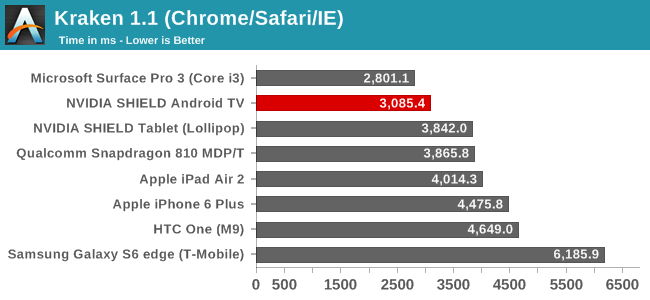
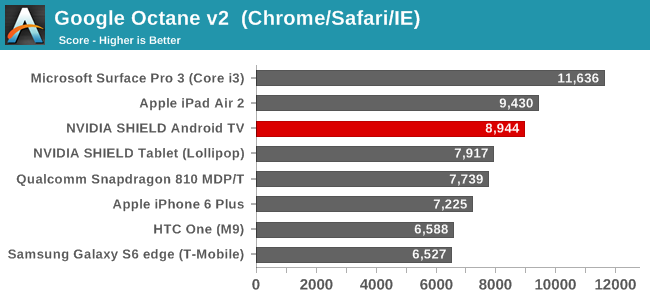
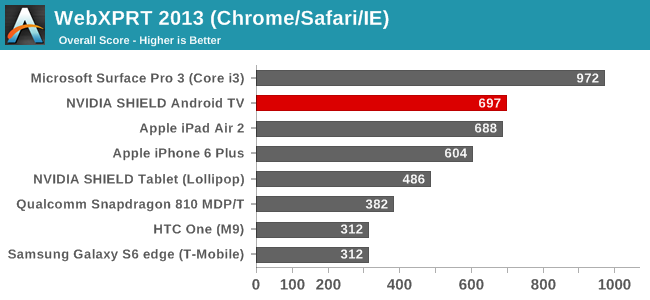
Among Android devices, the SHIELD Android TV stands alone, as you’d expect. Without any throttling to hold it back, it leads over Tegra K1, Snapdragon S810, and Exynos 7420 over all 3 web benchmarks. That said, even with its unrestricted Cortex-A57 CPU cores, we also find that Apple’s A8X-based iPad Air 2 is a close match in Octane and WebXPRT, just edging out the SHIELD Android TV and being edged out respectively. Meanwhile for anyone curious how this compares to high-end x86 tablets like the Surface Pro 3, well even SHIELD Android TV isn’t quite up to par with those devices at this time.
Moving on, we have Basemark OS II 2.0, which should give a better picture of CPU performance in addition to overall device performance.
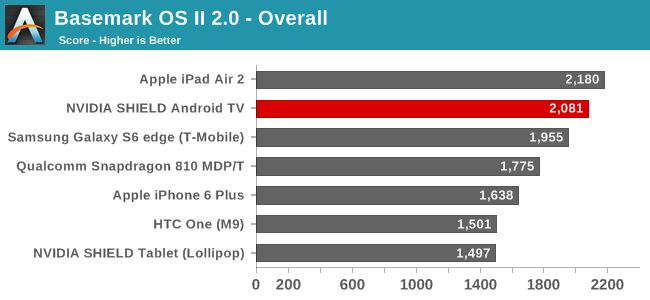

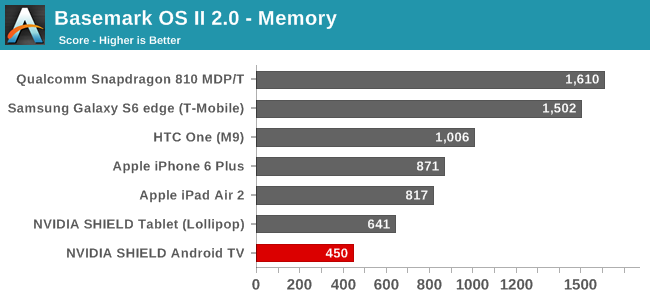
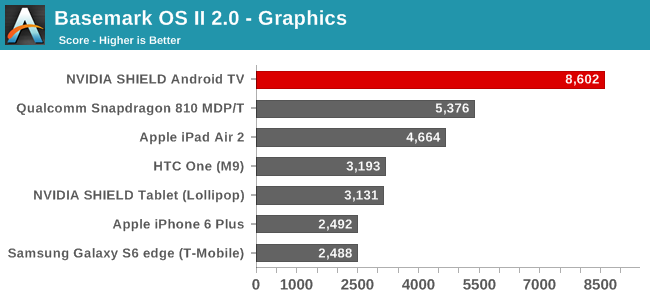
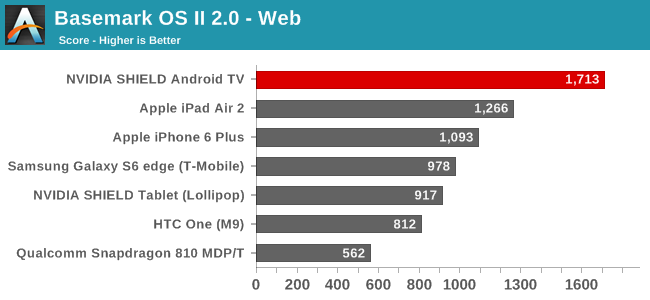
Overall, performance under Basemark still slightly favors the iPad Air 2. SHIELD Android TV easily takes the second spot, but it’s not enough to catch Apple’s tablet.
Looking at the subscores, we can see why this is. SHIELD Android TV only fares decently under the System test, but not well. The big surprise here is not the iPad, which always does well, but the fact that the SHIELD is so far behind the Galaxy S6, which features a similar CPU setup. As this sub-test pushes both the CPU and memory, we may be seeing something related to the implementation differences between Tegra X1 and Exynos 7420, or it may just be an Android TV-inspired difference.
However the memory score is particularly bad, coming in behind even the last-generation SHIELD Tablet. As this is a NAND test, what we're likely seeing is a consequence of the SHIELD's poor random performance, something we'll dive into a bit later in our detailed look at NAND performance.
On the other hand, graphics and web performance are outstanding. We had certainly expected the SHIELD to do well in graphics given what Maxwell is capable of – it is a graphics monster unlike any other current SoC – but the web test is a pleasant surprise. The combination of using Android TV’s built-in web view and the lack of any real throttling likely play a big part here, and although Android TV doesn’t ship with a standard web browser, this bodes well for any apps making use of web view and Javascript.
Our next system benchmark is PCMark, which does a number of basic benchmarks designed to stress various aspects of the device in everyday workloads like video playback, web browsing, text editing, and photo editing. This tends to test every aspect of a mobile device, unlike microbenchmarks that can often miss aspects of the system that can affect performance.
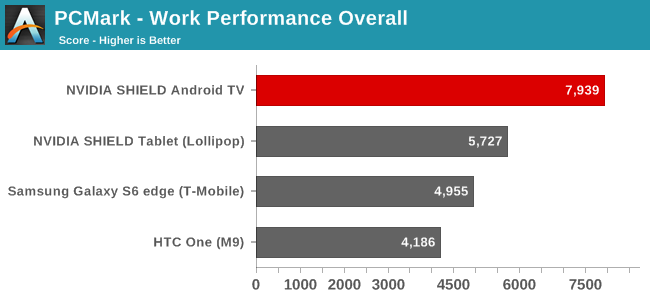
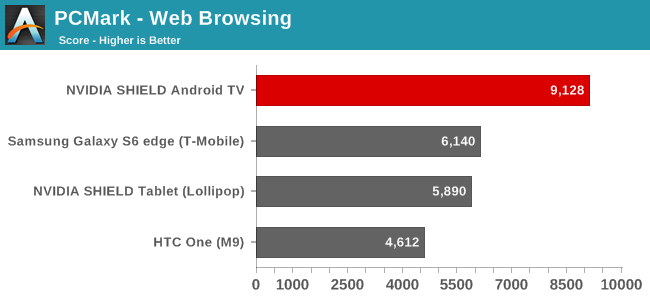

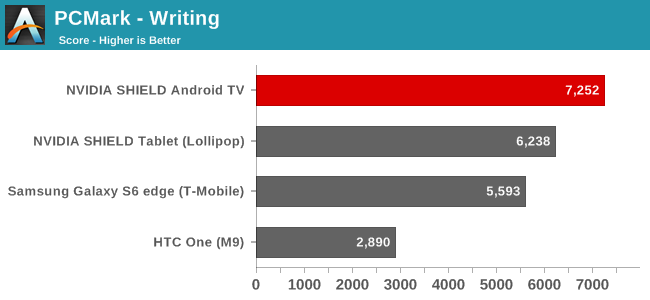
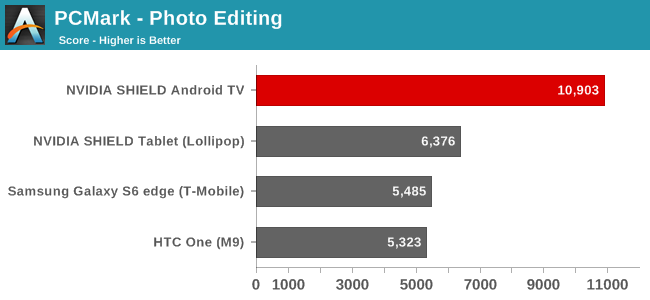
With the exception of the Writing subtest, where the SHIELD Android TV and second-place device are kind of close, PCMark is a runaway victory for the SHIELD Android TV. Once again we’re almost certainly seeing the benefits of the box’s aggressive performance since it doesn’t need to throttle down, or even be conservative on clockspeeds for power purposes. In which case it gives us an interesting look at what Cortex-A57 can do when not held back.
Overall, CPU/system performance is more or less what one would expect based on the design of the SHIELD. As a set top box with a quad-core A57 implementation under the hood and the cooling to let it run wild, SHEILD is frequently A57 at its best. Which means it’s going to easily surpass other A57 devices in most situations, but it also means that even with its unrestricted performance, Apple’s A8X processor and its tri-core “Enhanced Cyclone” CPUs still serve as a reminder of those times where A57 struggles against Enhanced Cyclone’s high-IPC design.
For our final look at system performance, let’s take a quick look at the SHIELD's built-in NAND performance with AndroBench 4.0.
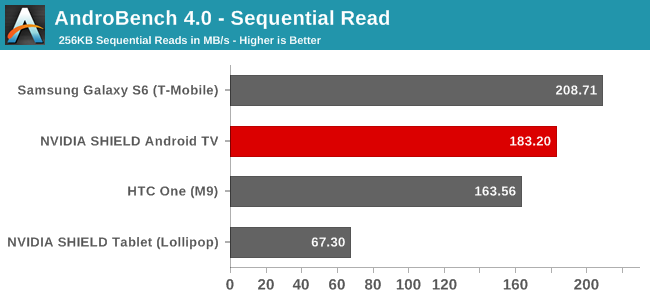
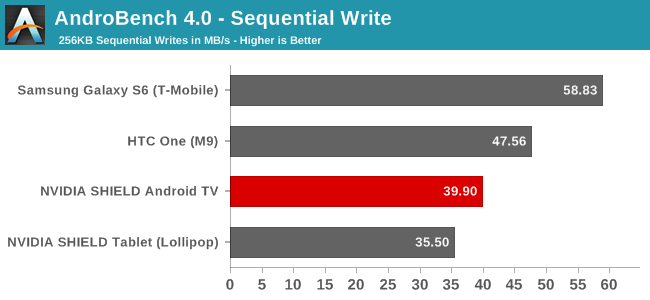
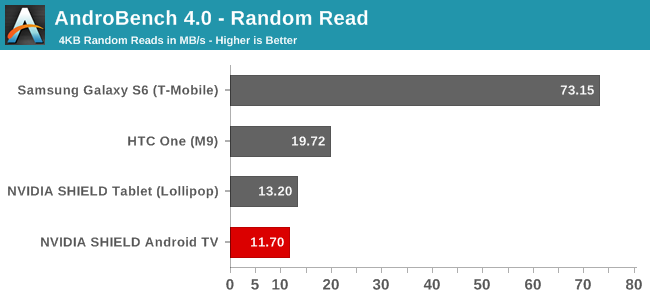
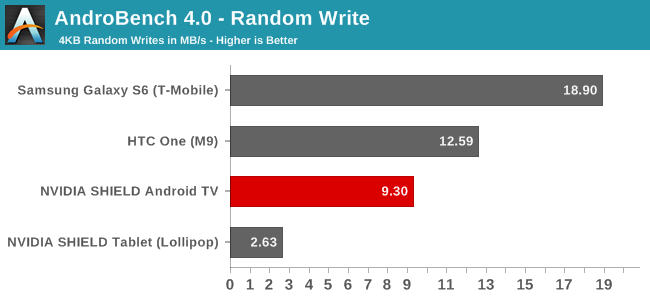
Update 5/28: AndroBench numbers have been revised to account for an error, sorry about that
Though we only have a few AndroBench 4.0 results compiled so far, it’s enough to paint a decent picture. For sequential reads the SHIELD’s built-in NAND fares relatively well. It’s not enough to top the Galaxy S6 and its UFS flash, but it’s keeping up with the pack. Sequential writes on the other hand aren't quite as good, with write performance ahead of only the SHIELD Tablet. Meanwhile random performance is a real mixed bag; the SHIELD Android TV is at the bottom of the random read chart - below even the SHIELD Tablet - while random write performnace is significantly better than the tablet, but still chasing the M9 and well off the S6.
Among Android flagship devices UFS definitely gives the Galaxy a big benefit here, but the SHIELD could stand to improve all the same. However I’m not sure how much that matters to NVIDIA, as the SHIELD is clearly designed to lean on external storage via microSD/USB for users who end up using it for storage-intensive needs such as gaming as opposed to basic set top box streaming.










167 Comments
View All Comments
ganeshts - Thursday, May 28, 2015 - link
From NV: "we do not have an empty HDD bay in the 16GB sku. Users will not be able to add their own HDD into the 16GB sku."ZOONAMI - Friday, May 29, 2015 - link
Wow thank you for prompt reply!Cami Hongell - Thursday, May 28, 2015 - link
Tellybean is the first video call service on Android TV and the SHIELD is the first device that works with a regular Logitech camera. Try it out and please let us know what you think. http://eepurl.com/blSzU9vdek - Thursday, May 28, 2015 - link
How does the performance compare to the XB1 and PS4? Those would seem to be the two immediate competitors for this device. It seems like Anandtech has grown too focused on comparing everything to Tablets/phones...kron123456789 - Thursday, May 28, 2015 - link
"How does the performance compare to the XB1 and PS4?" — It doesn't. This is just hardware:Sheild Android TV — 256 CUDA cores(at ~1GHz), 16ROPs, 16TMUs, 3GB of RAM with 25.6GB/sec bandwidth
Xbox One — 768 GCN cores(at 853MHz), 16ROPs, 48TMUs, 8GB of RAM with 68.2GB/sec bandwidth
PS4 — 1152 GCN cores(at 800MHz), 32ROPs, 72TMUs, 8GB of RAM with 176GB/sec bandwidth
ppi - Thursday, May 28, 2015 - link
Given that basically all TVs now are "smart", what are real advantages of device such as this one over a Smart TV? I am talking video and content playback, of course.While I do not own 4K TV, my 1080p Samsung has no trouble playing HD YouTube and variety of formats from USB disk.
jt122333221 - Thursday, May 28, 2015 - link
More content should be available on Android TV, and it's more likely to be updated than your TVs. Also, there are a lot of people who don't have a Smart TV and who would prefer NOT using their TV's smart features (I despise mine, the interface is horrible, apps are abysmal; only reason I have it is because it came with the TV I wanted).Yojimbo - Thursday, May 28, 2015 - link
I have a Samsung smart tv and it's slow, slow, slow.jeffkibuule - Thursday, May 28, 2015 - link
When's the last time your TV got a meaningful software update?TheJian - Friday, May 29, 2015 - link
You did see the gaming benchmarks right? If that wasn't a major point for the user, not sure why you would pay for this here other than playing all kinds of formats from your USB drives (flash etc), across the network (smart tv's usually not good at that either). Not to mention Grid gaming, which eliminates much of the need for a high end PC and constantly buying $60 games (be it console or PC).You have to be looking at this for more than just vids I think. IE you can do anything android devices can do. Meaning play their games, browse the web etc. I can sit on the couch and browse with a keyboard and mouse with this and a big screen (saving me a fat foot after 8hrs at work and some home time also on top). Too bad anandtech didn't bother to use it like this and comment.
I think SMART tv's are actually pretty stupid. They basically can stream some crap from netflix, youtube, amazon etc and not much more. Now if your tv has roku built-in or something, ok maybe sort of smarter but even that lacks major formats (really just has far more channels than smart tv's). My roku 2/3's are useless for USB sticks on about 80% of my content. I end up sticking it in the bluray player instead as most of the time it either can't play the audio or can't play the video.
If all you're after is movies and some streaming, I'd probably rather have a bluray player for $79-$99 that plays almost all formats from USB and streams fine, not to mention playing all disc formats (LG, BP350 $79 or something). Or even just a roku2 (new model with faster chip or roku 3 if using headphones in remote is needed) if just after streaming stuff but again, from usb sucks here, so I'm just talking web streaming vids.